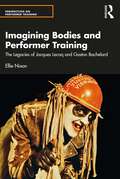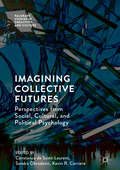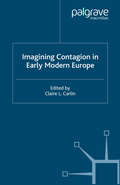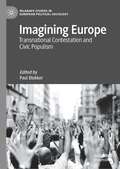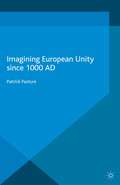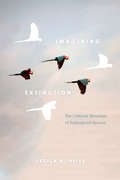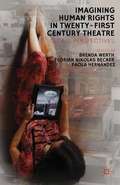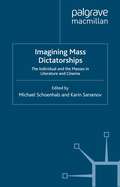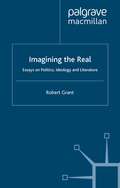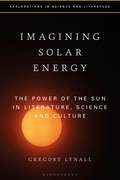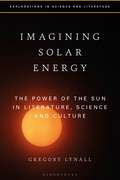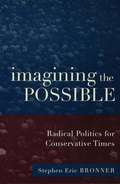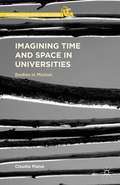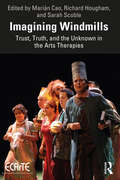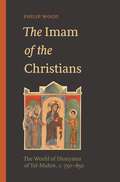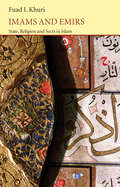- Table View
- List View
Imagining Bodies and Performer Training: The Legacies of Jacques Lecoq and Gaston Bachelard (Perspectives on Performer Training)
by Ellie NixonThis book is a practical and theoretical exploration of the embodied imagining processes of devised performance in which the human and more-than-human are co-implicated in the creative process.This study brings together the work of French theatre pedagogue Jacques Lecoq (1921–1999) and French philosopher of science and the imagination Gaston Bachelard (1884–1962) to explore the notion of the imagination as embodied, enactive and embedded in the devising process. An exploration of compelling correspondences with Bachelard, whose writings imbue Lecoq’s teaching ethos, offers new practical and theoretical perspectives on Lecoq’s ‘poetic body’ in contemporary devising practices. Interweaving first-hand accounts by the author and interviews with contemporary international creative practitioners who have graduated from or have been deeply influenced by Lecoq, Imagining Bodies in Performer Training interrogates how his teachings have been adapted, developed and extended in various cultural, political and historical settings, in Europe, Scandinavia, Asia, and North and South America.These new and rich insights reveal a teaching approach that resists fixity and instead unfolds, develops and adapts to the diverse cultural and political contexts of its practitioners, teachers and students.
Imagining Collective Futures: Perspectives from Social, Cultural and Political Psychology (Palgrave Studies in Creativity and Culture)
by Constance de Saint-Laurent Sandra Obradović Kevin R. CarriereIt is a commonly held assumption among cultural, social, and political psychologists that imagining the future of societies we live in has the potential to change how we think and act in the world. However little research has been devoted to whether this effect exists in collective imaginations, of social groups, communities and nations, for instance. This book explores the part that imagination and creativity play in the construction of collective futures, and the diversity of outlets in which these are presented, from fiction and cultural symbols to science and technology. The authors discuss this effect in social phenomena such as in intergroup conflict and social change, and focus on several cases studies to illustrate how the imagination of collective futures can guide social and political action. This book brings together theoretical and empirical contributions from cultural, social, and political psychology to offer insight into our constant (re)imagination of the societies in which we live.
Imagining Collective Futures: Perspectives from Social, Cultural and Political Psychology (Palgrave Studies in Creativity and Culture)
by Constance de Saint-Laurent Sandra Obradović Kevin R. CarriereIt is a commonly held assumption among cultural, social, and political psychologists that imagining the future of societies we live in has the potential to change how we think and act in the world. However little research has been devoted to whether this effect exists in collective imaginations, of social groups, communities and nations, for instance. This book explores the part that imagination and creativity play in the construction of collective futures, and the diversity of outlets in which these are presented, from fiction and cultural symbols to science and technology. The authors discuss this effect in social phenomena such as in intergroup conflict and social change, and focus on several cases studies to illustrate how the imagination of collective futures can guide social and political action. This book brings together theoretical and empirical contributions from cultural, social, and political psychology to offer insight into our constant (re)imagination of the societies in which we live.
Imagining Contagion in Early Modern Europe
by Claire L. CarlinThe ideological underpinnings of early modern theories of contagion are dissected in this volume by an integrated team of literary scholars, cultural historians, historians of medicine and art historians. Even today, the spread of disease inspires moralizing discourse and the ostracism of groups thought responsible for contagion; the fear of illness and the desire to make sense of it are demonstrated in the current preoccupation with HIV, SARS, 'mad cow' disease, West Nile virus and avian flu, to cite but a few contemporary examples. Imagining Contagion in Early Modern Europe explores the nature of understanding when humanity is faced with threats to its well-being, if not to its very survival.
Imagining Europe: Transnational Contestation and Civic Populism (Palgrave Studies in European Political Sociology)
by Paul BlokkerThis book provides an extensive analysis and discussion of the transnational mobilization of citizens and youth, alongside the production of creative, imaginative, and constructive solutions to the European crisis. The volume provides a variety of interdisciplinary analyses, as well as a series of perspectives on populism that have not been addressed extensively, including an examination of left-wing populism, the constituent power dimension of populism, and transnational manifestations of populism, contributing to debates on political science, political sociology, social movements studies, and political and constitutional theory.
Imagining European Unity since 1000 AD
by Patrick PastureEuropean unity is a dream that has appealed to the imagination since the Middle Ages. Its motives have varied from a longing for peace to a deep-rooted abhorrence of diversity, as well as a yearning to maintain Europe's colonial dominance. This book offers a multifaceted history that takes in account the European imagination in a global context.
Imagining Extinction: The Cultural Meanings of Endangered Species
by Ursula K. HeiseWe are currently facing the sixth mass extinction of species in the history of life on Earth, biologists claim—the first one caused by humans. Activists, filmmakers, writers, and artists are seeking to bring the crisis to the public’s attention through stories and images that use the strategies of elegy, tragedy, epic, and even comedy. Imagining Extinction is the first book to examine the cultural frameworks shaping these narratives and images. Ursula K. Heise argues that understanding these stories and symbols is indispensable for any effective advocacy on behalf of endangered species. More than that, she shows how biodiversity conservation, even and especially in its scientific and legal dimensions, is shaped by cultural assumptions about what is valuable in nature and what is not. These assumptions are hardwired into even seemingly neutral tools such as biodiversity databases and laws for the protection of endangered species. Heise shows that the conflicts and convergences of biodiversity conservation with animal welfare advocacy, environmental justice, and discussions about the Anthropocene open up a new vision of multispecies justice. Ultimately, Imagining Extinction demonstrates that biodiversity, endangered species, and extinction are not only scientific questions but issues of histories, cultures, and values.
Imagining Extinction: The Cultural Meanings of Endangered Species
by Ursula K. HeiseWe are currently facing the sixth mass extinction of species in the history of life on Earth, biologists claim—the first one caused by humans. Activists, filmmakers, writers, and artists are seeking to bring the crisis to the public’s attention through stories and images that use the strategies of elegy, tragedy, epic, and even comedy. Imagining Extinction is the first book to examine the cultural frameworks shaping these narratives and images. Ursula K. Heise argues that understanding these stories and symbols is indispensable for any effective advocacy on behalf of endangered species. More than that, she shows how biodiversity conservation, even and especially in its scientific and legal dimensions, is shaped by cultural assumptions about what is valuable in nature and what is not. These assumptions are hardwired into even seemingly neutral tools such as biodiversity databases and laws for the protection of endangered species. Heise shows that the conflicts and convergences of biodiversity conservation with animal welfare advocacy, environmental justice, and discussions about the Anthropocene open up a new vision of multispecies justice. Ultimately, Imagining Extinction demonstrates that biodiversity, endangered species, and extinction are not only scientific questions but issues of histories, cultures, and values.
Imagining Extinction: The Cultural Meanings of Endangered Species
by Ursula K. HeiseWe are currently facing the sixth mass extinction of species in the history of life on Earth, biologists claim—the first one caused by humans. Activists, filmmakers, writers, and artists are seeking to bring the crisis to the public’s attention through stories and images that use the strategies of elegy, tragedy, epic, and even comedy. Imagining Extinction is the first book to examine the cultural frameworks shaping these narratives and images. Ursula K. Heise argues that understanding these stories and symbols is indispensable for any effective advocacy on behalf of endangered species. More than that, she shows how biodiversity conservation, even and especially in its scientific and legal dimensions, is shaped by cultural assumptions about what is valuable in nature and what is not. These assumptions are hardwired into even seemingly neutral tools such as biodiversity databases and laws for the protection of endangered species. Heise shows that the conflicts and convergences of biodiversity conservation with animal welfare advocacy, environmental justice, and discussions about the Anthropocene open up a new vision of multispecies justice. Ultimately, Imagining Extinction demonstrates that biodiversity, endangered species, and extinction are not only scientific questions but issues of histories, cultures, and values.
Imagining Extinction: The Cultural Meanings of Endangered Species
by Ursula K. HeiseWe are currently facing the sixth mass extinction of species in the history of life on Earth, biologists claim—the first one caused by humans. Activists, filmmakers, writers, and artists are seeking to bring the crisis to the public’s attention through stories and images that use the strategies of elegy, tragedy, epic, and even comedy. Imagining Extinction is the first book to examine the cultural frameworks shaping these narratives and images. Ursula K. Heise argues that understanding these stories and symbols is indispensable for any effective advocacy on behalf of endangered species. More than that, she shows how biodiversity conservation, even and especially in its scientific and legal dimensions, is shaped by cultural assumptions about what is valuable in nature and what is not. These assumptions are hardwired into even seemingly neutral tools such as biodiversity databases and laws for the protection of endangered species. Heise shows that the conflicts and convergences of biodiversity conservation with animal welfare advocacy, environmental justice, and discussions about the Anthropocene open up a new vision of multispecies justice. Ultimately, Imagining Extinction demonstrates that biodiversity, endangered species, and extinction are not only scientific questions but issues of histories, cultures, and values.
Imagining Extinction: The Cultural Meanings of Endangered Species
by Ursula K. HeiseWe are currently facing the sixth mass extinction of species in the history of life on Earth, biologists claim—the first one caused by humans. Activists, filmmakers, writers, and artists are seeking to bring the crisis to the public’s attention through stories and images that use the strategies of elegy, tragedy, epic, and even comedy. Imagining Extinction is the first book to examine the cultural frameworks shaping these narratives and images. Ursula K. Heise argues that understanding these stories and symbols is indispensable for any effective advocacy on behalf of endangered species. More than that, she shows how biodiversity conservation, even and especially in its scientific and legal dimensions, is shaped by cultural assumptions about what is valuable in nature and what is not. These assumptions are hardwired into even seemingly neutral tools such as biodiversity databases and laws for the protection of endangered species. Heise shows that the conflicts and convergences of biodiversity conservation with animal welfare advocacy, environmental justice, and discussions about the Anthropocene open up a new vision of multispecies justice. Ultimately, Imagining Extinction demonstrates that biodiversity, endangered species, and extinction are not only scientific questions but issues of histories, cultures, and values.
Imagining Extinction: The Cultural Meanings of Endangered Species
by Ursula K. HeiseWe are currently facing the sixth mass extinction of species in the history of life on Earth, biologists claim—the first one caused by humans. Activists, filmmakers, writers, and artists are seeking to bring the crisis to the public’s attention through stories and images that use the strategies of elegy, tragedy, epic, and even comedy. Imagining Extinction is the first book to examine the cultural frameworks shaping these narratives and images. Ursula K. Heise argues that understanding these stories and symbols is indispensable for any effective advocacy on behalf of endangered species. More than that, she shows how biodiversity conservation, even and especially in its scientific and legal dimensions, is shaped by cultural assumptions about what is valuable in nature and what is not. These assumptions are hardwired into even seemingly neutral tools such as biodiversity databases and laws for the protection of endangered species. Heise shows that the conflicts and convergences of biodiversity conservation with animal welfare advocacy, environmental justice, and discussions about the Anthropocene open up a new vision of multispecies justice. Ultimately, Imagining Extinction demonstrates that biodiversity, endangered species, and extinction are not only scientific questions but issues of histories, cultures, and values.
Imagining Human Rights in Twenty-First Century Theater: Global Perspectives
by Florian N. Becker, Paola S. Hern�ndez, and Brenda WerthThere is extraordinary diversity, depth, and complexity in the encounter between theatre, performance, and human rights. Through an examination of a rich repertoire of plays and performance practices from and about countries across six continents, the contributors open the way toward understanding the character and significance of this encounter.
Imagining Mass Dictatorships: The Individual and the Masses in Literature and Cinema (Mass Dictatorship in the Twentieth Century)
by Michael Schoenhals and Karin SarsenovThis volume in the series Mass Dictatorship in the Twentieth Century series sees twelve Swedish, Korean and Japanese scholars, theorists, and historians of fiction and non-fiction probe the literary subject of life in 20th century mass dictatorships.
Imagining The Real: Essays on Politics, Ideology and Literature
by R. GrantThroughout its ten related essays, Imagining the Real contrasts our abstract imaginings about the human world with the imaginative insights provided by art and experience. It questions, variously, the relevance of game theory and sociobiology to politics; the supposed intrinsic values of liberal freedom, cultural change, and democratic action; and the claims of Marxism, deconstruction and 'Theory' generally to be non-ideological. More positively, it reinterprets fiction as a specific invitation to imagine, and celebrates Shakespeare, L.H. Myers and Beckett as truly critical, because truly imaginative, exponents of ideas.
Imagining Solar Energy: The Power of the Sun in Literature, Science and Culture (Explorations in Science and Literature)
by Gregory LynallHow has humanity sought to harness the power of the Sun, and what roles have literature, art and other cultural forms played in imagining, mythologizing and reflecting the possibilities of solar energy? What stories have been told about solar technologies, and how have these narratives shaped developments in science and culture? What can solar power's history tell us about its future, within a world adapting to climate crisis? Identifying the history of capturing solar radiance as a focal point between science and the imagination, Imagining Solar Energy argues that the literary, artistic and mythical resonances of solar power – from the Renaissance to the present day – have not only been inspired by, but have also cultivated and sustained its scientific and technological development. Ranging from Archimedes to Isaac Asimov, John Dee to Humphry Davy, Aphra Behn to J. G. Ballard, the book argues that solar energy translates into many different kinds of power (physical, political, intellectual and cultural), and establishes for the first time the importance of solar energy to many literary and scientific endeavours.
Imagining Solar Energy: The Power of the Sun in Literature, Science and Culture (Explorations in Science and Literature)
by Gregory LynallHow has humanity sought to harness the power of the Sun, and what roles have literature, art and other cultural forms played in imagining, mythologizing and reflecting the possibilities of solar energy? What stories have been told about solar technologies, and how have these narratives shaped developments in science and culture? What can solar power's history tell us about its future, within a world adapting to climate crisis? Identifying the history of capturing solar radiance as a focal point between science and the imagination, Imagining Solar Energy argues that the literary, artistic and mythical resonances of solar power – from the Renaissance to the present day – have not only been inspired by, but have also cultivated and sustained its scientific and technological development. Ranging from Archimedes to Isaac Asimov, John Dee to Humphry Davy, Aphra Behn to J. G. Ballard, the book argues that solar energy translates into many different kinds of power (physical, political, intellectual and cultural), and establishes for the first time the importance of solar energy to many literary and scientific endeavours.
Imagining the Possible: Radical Politics for Conservative Times
by Stephen Eric BronnerJean-Paul Sartre originally made the term engagement a part of the existentialist vocabulary following WWII. It imples the responsibility of intervening in social or political conflicts in the hope of fostering freedom. Imagining the Possible opens different windows upon this particular engagement.
Imagining the Possible: Radical Politics for Conservative Times
by Stephen Eric BronnerJean-Paul Sartre originally made the term engagement a part of the existentialist vocabulary following WWII. It imples the responsibility of intervening in social or political conflicts in the hope of fostering freedom. Imagining the Possible opens different windows upon this particular engagement.
Imagining Time and Space in Universities: Bodies in Motion (Curriculum Studies Worldwide)
by Claudia MatusImagining Time and Space in Universities presents critical theorizations of time and space to analyze discourses and practices of globalization and internationalization. As both dimensions have been understood in separate and hierarchical modes limited attention is given to cultural meanings embedded in these institutional policies and practices.
Imagining Windmills: Trust, Truth, and the Unknown in the Arts Therapies
by Marián Cao Richard Hougham Sarah ScobleImagining Windmills presents a compilation of scholarly chapters by selected authors of global standing in the arts therapies. This book reflects the theme of the 15th International Conference of the European Consortium for Arts Therapies (ECArTE), held in Alcalá de Henares, Spain, birthplace of Miguel de Cervantes. This innovative work seeks to further understanding of arts therapy education, practice and research and incorporates current thinking from art therapists, dance-movement therapists, dramatherapists and music therapists. Writers from Belgium, Germany, Greece, India, Israel, Italy, The Netherlands, Spain, Sweden, UK and USA combine to give an international voice to the book, which celebrates cultural distinctiveness, while also presenting shared intercultural developments in the professions. This interdisciplinary publication explores questions of the unknown and the imagined, misconception, delusion, truth and trust in the arts therapies. It enquires into ways in which education and the practice of the arts therapies engage with the imagination as a place of multiple realities, which may lead us closer to finding our truth. This book will be of interest and relevance not only to those in the arts therapeutic community, but also to a broad audience including those in related professions – for instance psychology, sociology, the arts, medicine, health and wellbeing and education.
Imagining Windmills: Trust, Truth, and the Unknown in the Arts Therapies
by Marián López Fdz Cao Richard Hougham Sarah ScobleImagining Windmills presents a compilation of scholarly chapters by selected authors of global standing in the arts therapies. This book reflects the theme of the 15th International Conference of the European Consortium for Arts Therapies (ECArTE), held in Alcalá de Henares, Spain, birthplace of Miguel de Cervantes. This innovative work seeks to further understanding of arts therapy education, practice and research and incorporates current thinking from art therapists, dance-movement therapists, dramatherapists and music therapists. Writers from Belgium, Germany, Greece, India, Israel, Italy, The Netherlands, Spain, Sweden, UK and USA combine to give an international voice to the book, which celebrates cultural distinctiveness, while also presenting shared intercultural developments in the professions. This interdisciplinary publication explores questions of the unknown and the imagined, misconception, delusion, truth and trust in the arts therapies. It enquires into ways in which education and the practice of the arts therapies engage with the imagination as a place of multiple realities, which may lead us closer to finding our truth. This book will be of interest and relevance not only to those in the arts therapeutic community, but also to a broad audience including those in related professions – for instance psychology, sociology, the arts, medicine, health and wellbeing and education.
The Imam of the Christians: The World of Dionysius of Tel-Mahre, c. 750–850
by Philip WoodHow Christian leaders adapted the governmental practices and political thought of their Muslim rulers in the Abbasid caliphateThe Imam of the Christians examines how Christian leaders adopted and adapted the political practices and ideas of their Muslim rulers between 750 and 850 in the Abbasid caliphate in the Jazira (modern eastern Turkey and northern Syria). Focusing on the writings of Dionysius of Tel-Mahre, the patriarch of the Jacobite church, Philip Wood describes how this encounter produced an Islamicate Christianity that differed from the Christianities of Byzantium and western Europe in far more than just theology. In doing so, Wood opens a new window on the world of early Islam and Muslims’ interactions with other religious communities.Wood shows how Dionysius and other Christian clerics, by forging close ties with Muslim elites, were able to command greater power over their coreligionists, such as the right to issue canons regulating the lives of lay people, gather tithes, and use state troops to arrest opponents. In his writings, Dionysius advertises his ease in the courts of ʿAbd Allah ibn Tahir in Raqqa and the caliph al-Ma’mun in Baghdad, presenting himself as an effective advocate for the interests of his fellow Christians because of his knowledge of Arabic and his ability to redeploy Islamic ideas to his own advantage. Strikingly, Dionysius even claims that, like al-Ma’mun, he is an imam since he leads his people in prayer and rules them by popular consent.A wide-ranging examination of Middle Eastern Christian life during a critical period in the development of Islam, The Imam of the Christians is also a case study of the surprising workings of cultural and religious adaptation.
The Imam of the Christians: The World of Dionysius of Tel-Mahre, c. 750–850
by Philip WoodHow Christian leaders adapted the governmental practices and political thought of their Muslim rulers in the Abbasid caliphateThe Imam of the Christians examines how Christian leaders adopted and adapted the political practices and ideas of their Muslim rulers between 750 and 850 in the Abbasid caliphate in the Jazira (modern eastern Turkey and northern Syria). Focusing on the writings of Dionysius of Tel-Mahre, the patriarch of the Jacobite church, Philip Wood describes how this encounter produced an Islamicate Christianity that differed from the Christianities of Byzantium and western Europe in far more than just theology. In doing so, Wood opens a new window on the world of early Islam and Muslims’ interactions with other religious communities.Wood shows how Dionysius and other Christian clerics, by forging close ties with Muslim elites, were able to command greater power over their coreligionists, such as the right to issue canons regulating the lives of lay people, gather tithes, and use state troops to arrest opponents. In his writings, Dionysius advertises his ease in the courts of ʿAbd Allah ibn Tahir in Raqqa and the caliph al-Ma’mun in Baghdad, presenting himself as an effective advocate for the interests of his fellow Christians because of his knowledge of Arabic and his ability to redeploy Islamic ideas to his own advantage. Strikingly, Dionysius even claims that, like al-Ma’mun, he is an imam since he leads his people in prayer and rules them by popular consent.A wide-ranging examination of Middle Eastern Christian life during a critical period in the development of Islam, The Imam of the Christians is also a case study of the surprising workings of cultural and religious adaptation.
Imams and Emirs: State, Religion and Sects in Islam (Saqi Essentials #3)
by Fuad I. KhuriIn this classic, comprehensive study of Islamic sects in the contemporary Arab world, Khuri focuses on the Sunni, Shi'a, Alawis, Druze, Ibadis, Zaidis, Yazidis and the Maronites (who, although Christian, are included because they share certain distinguishing features). His placements of these groups on a single comparative scale was unprecedented. Khuri argues that conflicts among Muslims arise from the struggle between two opposing forces: religious, doctrinaire authorities (imams) and leaders who derive their authority from power and coercion (emirs). He discusses the role of dogma but also, uniquely, the critical factors that differentiate sects from religious communities and religions from sects. Following a thorough review of the structural characteristi of individual sects, Khuri addresses issues of religious change, dealing with the interplay between religions, states and nationalism. Here he explores the contradictions between modern state structures and the Islamic umma, showing how some religious concepts had begun to take on nationalistic meanings. 'Readers in a variety of fields will find this book a reliable source well researched, amply documented and highly readable.' -- Middle East Journal 'An excellent book.' -- Middle East International 'The relationship of authority and political culture among the Sunni and the Shi'a receives extensive treatment. The author's direct interaction with various ulema and his exposition of their views is useful.' -- International Journal of Middle East Studies
